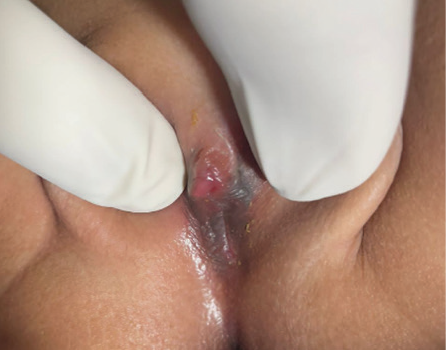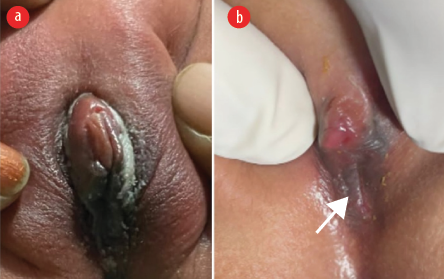A one-year-old girl was brought to the gynecological clinic by her mother, who noticed that she could no longer see the baby’s vaginal orifice while changing diapers. The mother reported that the vaginal orifice had appeared normal and open at birth. She denied any history of trauma or occurrence of lesions on the vulva. The child passed an uninterrupted stream of urine without discomfort, had normal height and weight for her age, and had achieved all her developmental milestones. Her abdomen was soft, non-tender, with no palpable mass. An examination of external genitalia [Figure 1] revealed a fusion of labia minora up to the urethral opening. The baby resisted as we tried to separate the labia manually.
 Figure 1: The external examination of the vulva.
Figure 1: The external examination of the vulva.
Question
1. What is your diagnosis?
a. Mayer-Rokitansky-Küster-Hauser syndrome.
b. Imperforate hymen.
c. Labial fusion.
d. Ambiguous genitalia.
See Figure 2 for a comparison of a normal-appearing labia minora and fused labia minora in the
present case.
 Figure 2: (a) Physical examination of the vulva showing normal labia minora in a child. (b) Fused labia minora up to urethral meatus in our case
Figure 2: (a) Physical examination of the vulva showing normal labia minora in a child. (b) Fused labia minora up to urethral meatus in our case
(white arrow).
2. What treatment is appropriate for the above patient?
a. Immediate surgical intervention.
b. Topical estrogen application.
c. No treatment as the child has no symptoms.
d. Bedside mechanical separation.
Answer
1. a. Labial fusion.
2. c. No treatment as the child has no symptoms.
Discussion
Labial fusion or labial adhesion, is the fusion of labia minora, typically occurring near the clitoris due to the development of a thin fibrotic tissue, which results in a complete or partial closure of the vaginal orifice.1 It is generally an acquired condition observed in young girls and is often mistaken for a genital anomaly. Acquired adhesions are reported in approximately 1.8% of girls, most commonly in the 13–23 months age group.2
Though the exact pathology is unknown, cases of acquired adhesion are mostly associated with low estrogen levels in pre-adolescent girls. For the same reason, it is also seen in post-menopausal women. Other known causes are chronic inflammation, vulvar infection (e.g., genital herpes), poor hygiene, genital trauma, female mutilation, and sexual abuse. Most cases are asymptomatic and noticed by caretakers during routine physical care. Some may develop symptoms like changes in the urinary stream, dribbling of urine, and urinary tract infections. Some severe cases present with acute retention of urine.3 Therefore, it is imperative to check for urinary tract infection in all cases of labial fusion. Clinicians should also consider differential diagnoses such as imperforate hymen, hymenal tags, urethral prolapse, and vaginal atresia.
In around 80% of the cases, the condition causes no pain and resolves spontaneously without treatment in puberty, when the effect of estrogen causes changes in cells lining the genitals.1 Reassurance and counseling of the parents are the mainstay of treatment. In symptomatic cases, conjugated estrogen cream (0.01%) is applied one to two times daily for 3–4 weeks or until the adhesion resolves. Mechanical separation is another option. However, both treatment modalities carry a risk of recurrence.4,5 A minority of cases may need surgical separation, where the adhesion is thick or manual separation is impossible. Irrespective of the treatment mode, the recurrence rate of adhesion is as high as 40%.1 Thus, parents of the child should be thoroughly counseled regarding the cause, treatment options, and the possibility of recurrence.
Disclosure
The authors declare no conflicts of interest. Informed consent was obtained from the patient’s father.
references
- Mohapatra I, Samantaray SR. Labial fusion recurrence in a prepubertal girl: a case report and review of literature. Cureus 2022 Jun;14(6):e26059.
- Leung AK, Robson WL, Tay-Uyboco J. The incidence of labial fusion in children. J Paediatr Child Health 1993;29(3):235-236.
- Gonzalez D, Anand S, Mendez MD. Labial adhesions. Treasure Island (FL): StatPearls Publishing; 2024. [cited 2024 September 30]. Available from: https://www.ncbi.nlm.nih.gov/books/NBK470461/.
- Wejde E, Ekmark AN, Stenström P. Treatment with oestrogen or manual separation for labial adhesions - initial outcome and long-term follow-up. BMC Pediatr 2018 Mar;18(1):104.
- Bussen S, Eckert A, Schmidt U, Sütterlin M. Comparison of conservative and surgical therapy concepts for synechia of the labia in pre-pubertal girls. Geburtshilfe Frauenheilkd 2016 Apr;76(4):390-395.